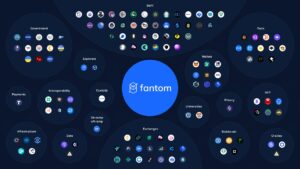
Fantom is a low-gas-fee dApp platform which is also Ethereum Virtual Machine (EVM) compatible. It has the advantage of being a layer-1 platform just like Ethereum, while having extremely low gas fees just like Polygon (which is a layer-2 built on top of Ethereum).
At time of writing, it’s rare for even the heaviest gas users to pay more than a fraction of a penny (USD) per transaction. (Data resources on average transaction fee are scarce, but a gas tracker at the ftmscan block explorer provides a good snapshot and you can use resources at ftmscan.com/charts to pull historical data and calculate it.)
This is part of a series of posts introducing Axelar-connected chains to builders. With Axelar’s secure cross-chain communication, Web3 developers build on the platform that best suits their use case, and provide one-click experiences that link their users to assets and liquidity on any connected chain. To find out more about building cross-chain with Axelar, visit Axelar’s docs, see the list of connected chains and check out a set of example dApps on the Axelar GitHub.
With secure cross-chain communication, developers can take advantage of these features, without sacrificing access to assets, users, liquidity and complementary functions on other ecosystems. Axelar’s General Message Passing makes it possible to build dApps on Fantom that connect seamlessly to these resources, across all of Web3.
An example swap transaction on Fantom’s block explorer shows the low fee per transaction. The block explorer also provides a chart showing daily average, minimum and maximum gas price.
Innovative consensus = low-gas-fee dApp platform
Fantom is a low-gas-fee platform because of these factors:
- Fantom is not technically a blockchain. It uses directed acyclic graph (DAG), which enables parallelism in the block generation mechanism. Unlike the traditional block generation mechanism in the Ethereum chain, which utilizes a linked list to form blocks, Fantom network lets miners connect new transactions to any existing transaction simultaneously, as long as there aren’t any conflicts in these transactions.
- Fantom uses an innovative consensus mechanism called Lachesis, developed specially for directed acyclic graph (DAG) architecture of the Fantom network. Lachesis is an asynchronous Byzantine Fault Tolerance (aBFT) consensus algorithm.
Low-gas-fee dApp platform + familiar programing language = growing ecosystem
The main reason developers are building applications on Fantom is because it is a low-latency, low-gas-fee dApp platform. The Fantom ecosystem now has over 100+ protocols integrated, with more being added on a regular basis, including numerous APIs, bridges, oracles, dApps, components explorers, storage providers and Web3 wallets.
Additionally, Fantom is an EVM-compatible chain that uses the Solidity smart-contract language. Solidity is perhaps the most popular and mature smart-contract programming language. There are more resources for developers, relative to other languages – e.g., libraries, resources and examples for newcomers to learn and reuse.
Resources for learning to develop dApps in Solidity
To get started, you should have some basic programming skills and mindset. You must also have experience in the JavaScript language. You can learn basic programming skills by participating in JavaScript for beginner courses which can be found widely. Here’s a gamification course we like: CryptoZombies. It is really easy to start.
Once you have basic Solidity programming skills, you should learn the overview of Solidity syntax. We recommend Tutorialspoint Solidity Tutorial, because of its structure and coverage.
After you have learned the overall syntax of Solidity, you can proceed to read basic yield-farming smart contracts, which are not too complex to learn. You can learn from an old version of PancakeSwap’s farm smart contract in their GitHub repository, here.
Finally, once you have experience in smart contract development, you are ready to develop your own basic smart contract to build your dApps. You can also continue to learn from more complex smart contracts such as the lending system.
With Fantom, you can do your own experiments on mainnet without worrying about high gas fees. However, experimenting on the mainnet is still discouraged. You should experiment on testnet unless it isn’t possible for your use case.
Take a look at Axelar’s cross-chain utilities for Solidity devs.
Solidity developer tools
There are many developer tools involved in developing a Solidity smart contract. The most basic tool for newbies is Remix IDE, which packs all related tools required to build a smart contract into one tool.
But the weak point of Remix IDE is when your project becomes bigger with more dependencies it will be hard to manage. In this case, Hardhat comes into play. Hardhat is a development environment for Solidity, just like Remix IDE, except that Hardhat is more customizable, has more plugins and can be shared across your team. (If you have experience in developing React websites, you can view Hardhat as a Create React App tool.)
Some projects require integration with a tool or SDK that is only available on mainnet, such as Rango Exchange SDK. In this case, Fantom is a good chain for experimentation, because of the low gas fee.
Cross-chain interoperability expands Fantom’s utility
With cross-chain interoperability, developers can build on a low-gas-fee dApp platform like Fantom, without sacrificing access to users and liquidity. Across-chain application can use Fantom network to perform computationally intensive tasks, while interoperating with assets, users and other functions on other chains.
For example, You can use Axelar’s General Message Passing to allow users to bring an Ethereum-based NFT into a Fantom dApp. A high-level blog post from the Axelar team explains how this is possible, and specific functions are spelled out in the Axelar docs. Examples of how this is possible are already being built, including AxelarSea, a cross-chain NFT marketplace. This is in addition to basic bridging capabilities that bring wrapped versions of fungible tokens into and out of the Fantom ecosystem.
The expanding Fantom ecosystem
Fantom’s ecosystem now has over 100+ protocols integrated, with more being added on a regular basis, including numerous APIs, bridges, oracles, dApps, DeFi, components explorers, storage providers, and Web3 wallets.

Source: https://twitter.com/FantomFDN/status/1422211891657576452
You can find complete list of dApps on Fantom using Defi Llama.
DeFi apps and dexes in particular value Fantom as a low-gas-fee dApp platform. Here are a few examples of dApps building on Fantom:
SpookySwap
SpookySwap is a major dex on Fantom chain with more than $200M TVL. DApp developers looking to launch their own token on Fantom can provide liquidity to SpookySwap to enable users to trade their tokens.
SpookySwap uses an AMM (Automated Market Maker) algorithm to enable users to trade on particular tokens have liquidity provider (LP) support.
Solidly Finance
Solidly Finance was hugely inspired by Curve. On Curve, users are incentivized to lock their CRV and receive veCRV that is used for voting and receiving trading fee distribution. Solidly incentivized users by giving veSOLID to users that lock the SOLID token. VeSOLID holders get fees generated by the swaps, SOLID reward from inflation and voting rights.
Solidly Finance is also a DEX swap system which works in a similar way to how SpookySwap works. However, Solidly adds governance features, where users can participate in choosing the right pool by voting.
Summary
Fantom network is a low-gas-fee dApp platform. This is due to the directed acyclic graph (DAG) architecture and Lachesis consensus that the Fantom network uses. Developers can leverage existing knowledge of Solidity based smart contracts to develop on Fantom as Fantom is an EVM-compatible chain. Additionally, developers can use message passing protocols such as Axelar to connect their dApps with other chains. Fantom also has an expanding ecosystem ready for development of new dApps.



